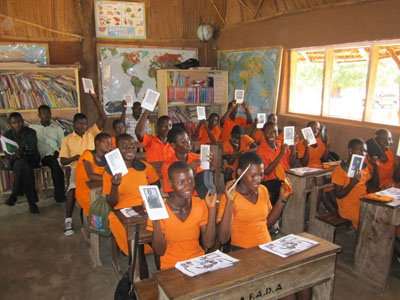This post was co-written by Jeffrey Swindle
To improve education quality in Malawi, USAID Malawi implemented the Tikwere Interactive Radio Instruction (IRI) program. The IRI program has affected over three million children and 22,000 teachers since it began in May 2007. Furthermore, management and financing of the program is now moving to the hands of the government, letting USAID allocate its efforts to additional endeavors.
Despite promising increases in primary education enrollment (54% to 70% from 1999 to 2006) in Sub-Saharan Africa, the quality of education is quite low. High teacher and student absence rates, as well as low achievement scores, plague education systems. When researchers make unannounced visits to schools, teachers are absent on average 19% of the time, with higher rates in rural areas.
In Malawi, the situation is particularly grim. According to the Southern Africa Consortium on Monitoring Education Quality (SACMEQ), fewer than 25% of eligible Malawian children remain in school by grade 8. In addition, only 9% of primary school students were found to have reached a minimum level of mastery in reading in English, and a mere 2% of pupils possessed skills beyond basic numeracy.

Photo credit: USAID/Malawi
To address these challenges, USAID Malawi began the IRI program. In the program, schools are provided with radios, and they listen to a thirty-minute national broadcast each day. Teachers receive text messages on their phones telling them the weekly schedule for the in-service broadcasts prior to the beginning of the term, and through lesson plans produced by Tikwere teachers are informed about what materials they will need to prepare beforehand (posters, pencils, textbooks, etc.). The broadcast focuses on one of three topics: the local language Chichewa, English, and life skills. The broadcasts are prepared professionally and incorporate ideal teaching strategies, including group work, learner-focused discussions, and gender balanced teaching. By listening to the broadcast, teachers learn how they can be most effective. And the students benefit because they receive training from an optimal teacher via radio each day.
Amongst these learners there have been increases in test scores for standard 1 learners in literacy (17% points higher in English and 9% points higher in Chichewa compared to non-participating students) and mathematics (12% points higher than non-participating students).

Photo credit: USAID/Malawi
Additionally, they are particularly engaged during the radio broadcasts; the students anxiously look forward to this special time each day and enrollment has been rising in Tikwere schools which cover over 95% of the 5,300 schools nationwide.
To implement the program, USAID purchased 13,000 freeplay radios which are solar powered at a total cost of $386,400 over a course of three years. Additionally, printed materials to accompany the activities and radio airtime required additional funding. Using conservative estimates, over 2,000,000 children listening to the broadcasts for the first three years. If the same rate of expansion of the project continued, the IRI program affects far more than 3,000,000 million children in Malawi. The total cost per student per year is $0.16, a bargain for improved educational achievement and teacher effectiveness. Currently, the USAID mission to Malawi is working with the government to incorporate the program into the national education plan and finances, making the program financial sustainable without further support from USAID.

Table: Project Total Estimates from Macro International
The final impacts of the IRI program, however, are yet to be measured. Macro International conducted a mid-term evaluation of the project in 2009. Though the IRI program was able to reach approximately 75% of schools in Malawi, at least 10% do not have the connectivity for the radios to work, and the costs were too high and complicated for USAID to provide alternative technologies for IRI. In an ingenious strategy, Tikwere uses this 5% as a control comparison for the learner assessments of the IRI program. Thus far, schools with the Tikwere IRI program show a 17% gain in scores over the control schools.

Photo credit: USAID/Malawi
Originally Zambia implemented the IRI methodology for the out of school program. Because of IRI’s potential for success, the government there adopted it in the conventional schools. Malawi’s experience is adopted from the Taonga Market in Zambia, and other USAID missions have implemented similar programs as well. Hopefully, more missions around the world will implement similar radio programs and see equal impacts.

















































